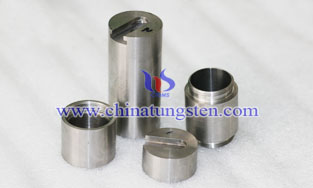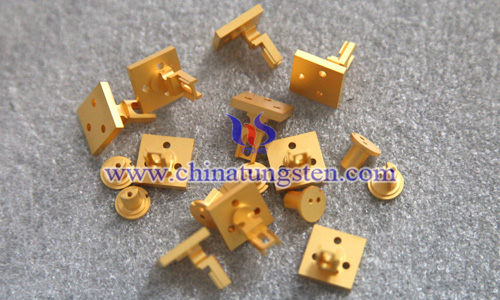Ammonium Paratungstate Market(APT) Keeps Inactive In China
- Details
- Category: Tungsten's News
- Published on Friday, 17 May 2013 09:42
- Hits: 2448
Chinea ammonium paratungstate market (APT) continuous to be quiet this week, and the offers move up further.
However, owing to the soft demand from the downstream markets, many downstream customers are cautious in making deals and the transaction prices do not recover.An ammonium paratungstate (APT) factory based in China, whose output is around 200 tons per month, noted the ammonium paratungstate market (APT) keeps inactive.
You can visit the following links for more information about APT prices. Thank you very much!
Tungsten Manufacturer & Supplier: Chinatungsten Online - http://www.chinatungsten.com
Tel.: 86 592 5129696; Fax: 86 592 5129797
Email: sales@chinatungsten.com
Tungsten Picture Center: http://picture.chinatungsten.com
Tungsten Video Center: http://v.chinatungsten.com
Tungsten News & Tungsten Prices, 3G Version: http://3g.chinatungsten.com
Ammonium Paratungstate Market(APT) On May 10,2013
- Details
- Category: Tungsten's News
- Published on Thursday, 16 May 2013 14:01
- Hits: 2283
Ammonium paratungstate preices (APT prices) move up further
Owing to the guiding prices and the increasing tungsten concentrate prices, ammonium paratungstate(APT) suppliers raise offers further.
The APT market sees some higher offers in the spot market, but the transaction prices do not recover. Most of the APT market participants hold wait-and-see attitudes towards the future market.
You can visit the following links for more information about APT prices. Thank you very much!
Tungsten Manufacturer & Supplier: Chinatungsten Online - http://www.chinatungsten.com
Tel.: 86 592 5129696; Fax: 86 592 5129797
Email: sales@chinatungsten.com
Tungsten Picture Center: http://picture.chinatungsten.com
Tungsten Video Center: http://v.chinatungsten.com
Tungsten News & Tungsten Prices, 3G Version: http://3g.chinatungsten.com
European Ferro-tungsten Prices Shoot Up
- Details
- Category: Tungsten's News
- Published on Thursday, 16 May 2013 13:55
- Hits: 2549
The tightness of supply in the European ferro-tungsten market is showing no signs of abating this week, with both consumers and traders reporting difficulties in finding willing sellers of material in Europe.
On Wednesday, consumer tender sale prices reached just above USD47.00/kg W d.d.p, an increase of more than USD1.00/kg W since Monday, and mainstream offers ranged between USD46.00-47.50/kg W in warehouse Rotterdam.
One European based ferro-tungsten trader confirmed that he sold a truckload of ferro-tungsten at USD47.20/kg W d.d.p to a European steel plant on Wednesday, and stated that the tightness in the availability of material is continuing to drive prices upward.
He added that mainstream prices of the noble alloy have increased a further USD1.00/kg W since Monday to range between USD46.00-47.50/kg W in warehouse Rotterdam as of Wednesday.
You can visit the following links for more information about ferro-tungsten prices. Thank you very much!
Tungsten Manufacturer & Supplier: Chinatungsten Online - http://www.chinatungsten.com
Tel.: 86 592 5129696; Fax: 86 592 5129797
Email: sales@chinatungsten.com
Tungsten Picture Center: http://picture.chinatungsten.com
Tungsten Video Center: http://v.chinatungsten.com
Tungsten News & Tungsten Prices, 3G Version: http://3g.chinatungsten.com
Ammonium Paratungstate Prices (APT) On May 16,2013
- Details
- Category: Tungsten's News
- Published on Thursday, 16 May 2013 13:50
- Hits: 2487
Ammonium paratungstate preices (APT prices) keep uptrend
China ammonium paratungstate offers keep uptrend, but the transaction prices did not recover, and most of the APT market participants hold wait-and-see attitudes towards the future market with firm offers.
An ammonium paratungstate (APT prices) factory noted that they make offers for APT at RMB197,000t USD359mtu this week, which increased slightly compared with those before.
You can visit the following links for more information about APT prices. Thank you very much!
Tungsten Manufacturer & Supplier: Chinatungsten Online - http://www.chinatungsten.com
Tel.: 86 592 5129696; Fax: 86 592 5129797
Email: sales@chinatungsten.com
Tungsten Picture Center: http://picture.chinatungsten.com
Tungsten Video Center: http://v.chinatungsten.com
Tungsten News & Tungsten Prices, 3G Version: http://3g.chinatungsten.com
Tungsten Concentrate Prices On May 16, 2013
- Details
- Category: Tungsten's News
- Published on Thursday, 16 May 2013 13:45
- Hits: 2397
China tungsten concentrate prices remain stable.
In the recent days, the tungsten concentrate prices remained stable, and most of the market participants still hold wait-and-see attitudes towards the future market.
A tungsten concentrate factory based in South China noted that they make offers for wolframite 55% at RMB130,000-131,000t USD322-325mtu this week, which keep stable.
You can visit the following links for more information about tungsten concentrate prices. Thank you very much!
Tungsten Manufacturer & Supplier: Chinatungsten Online - http://www.chinatungsten.com
Tel.: 86 592 5129696; Fax: 86 592 5129797
Email: sales@chinatungsten.com
Tungsten Picture Center: http://picture.chinatungsten.com
Tungsten Video Center: http://v.chinatungsten.com
Tungsten News & Tungsten Prices, 3G Version: http://3g.chinatungsten.com
Tungsten Carbide's Passive Situation
- Details
- Category: Tungsten's News
- Published on Thursday, 16 May 2013 11:55
- Hits: 2486
Today, the field of carbide is highly competitive. Although tungsten carbide is still the main material of the cutting, mining, etc., it is facing the passive situation that some fields is substituted by Diamond. Competitive advantage of tungsten carbide is not very clear: compared with domestic enterprises, product quality has no significant difference. But the production and variety are not as goog as strains hard alloy (over 5000 tons), and there is no clear catch-up schedule.
Tungsten Manufacturer & Supplier: Chinatungsten Online - http://www.tungsten-carbide.com.cn
Tel.: 86 592 5129696; Fax: 86 592 5129797
Email: sales@chinatungsten.com
Tungsten Picture Center: http://picture.chinatungsten.com
Tungsten Video Center: http://v.chinatungsten.com
Tungsten News & Tungsten Prices, 3G Version: http://3g.chinatungsten.com
Tool Material Enters into the Tungsten Carbide Era
- Details
- Category: Tungsten's News
- Published on Thursday, 16 May 2013 11:48
- Hits: 2359
Experts believe that the tool material has entered the era of tungsten carbide, comparing with the high-speed steel, tungsten carbide has better performance and higher cutting efficiency, the same as superhard materials, it is an important guarantee for the efficient processing of modern cutting technology. Currently, our tungsten carbide cutting tools' proportion is up to 40%, which is far less than the level of the industrial countries and severely restricts the overall level improvement of our tool products. Without a good tool materials, tool innovation and progress of the cutting process are short of the necessary material basis. A fundamental solution to this Problem,it relates to the adjustment of industry structure, and speed up the process of building a tungsten carbide materials and researching the tool production base.
Tungsten Manufacturer & Supplier: Chinatungsten Online - http://www.tungsten-carbide.com.cn
Tel.: 86 592 5129696; Fax: 86 592 5129797
Email: sales@chinatungsten.com
Tungsten Picture Center: http://picture.chinatungsten.com
Tungsten Video Center: http://v.chinatungsten.com
Tungsten News & Tungsten Prices, 3G Version: http://3g.chinatungsten.com
China's Tungsten Carbide Industry's Existing Problems
- Details
- Category: Tungsten's News
- Published on Thursday, 16 May 2013 11:42
- Hits: 2572
The main problems of tungsten carbide industry in China are the following, first, small scale enterprises, industry concentration is not high. According to incomplete statistics, 199 tungsten carbide enterprises' average annual production capacity is 176 tons, with an average annual production of 86 tons, only 4 can get annual output of more than 1,000 tons. Second, less investment in science and technology, and the lack of high-end technical personnel, R & D capability is weak. Tungsten carbide industry's inputs in China in science and technology is less than 3% of the sales revenue, scientific technical and R & D level is not high. Third, the level of product quality is low, product structure needs to be adjusted. The production of tungsten carbide in China accounted for more than 40% of world production, but tungsten carbide sales income is less than 20% of the world, it is because the high-performance ultra-fine alloy, high-performance precision grinding blade coating, super-hard tool materials, complexity products, precision carbide CNC tool and high value-added products is less, the deep processing facilities is insufficient as well as due to incomplete varieties.
Tungsten Manufacturer & Supplier: Chinatungsten Online - http://www.tungsten-carbide.com.cn
Tel.: 86 592 5129696; Fax: 86 592 5129797
Email: sales@chinatungsten.com
Tungsten Picture Center: http://picture.chinatungsten.com
Tungsten Video Center: http://v.chinatungsten.com
Tungsten News & Tungsten Prices, 3G Version: http://3g.chinatungsten.com
Tungsten Carbide Bar’s Rising Demand
- Details
- Category: Tungsten's News
- Published on Wednesday, 15 May 2013 18:04
- Hits: 2538
In recent years, the domestic production of tungsten carbide bar has been growing, but with the growing demand, the market demand outstrips supply, the demand for quality inspection is also facing difficulties. Detection of domestic tungsten carbide bar is commonly manual, it consumes more labor power, and the test result is unstable, thus automated testing equipment gradually is more favored by the majority of manufacturers.
According to related statistics, tungsten carbide bar includes high hardness, high wear resistance, high strength, and resistance to bending, long tool life and a series of excellent performance. Tungsten carbide bar is the blank material of producing drill and cutting tool, at present, it mainly adopts powder extrusion molding process. It is now widely used in producing drill, automotive tools, printed circuit board tool, engine tool, solid end mills, the overall reamer, chisel, etc., but also in producing the punch, mandrel, top and punch tool.
With the surge in market demand, the ultra-fine grain tungsten carbide bar has been more and more widely used. In the field of high-speed cutting tool, due to the high standards of safety, reliability and durability, internal and surface quality requirements of overall tungsten carbide cutting tools are more stringent. However, with the quality of tungsten carbide bar especially the ultrafine carbide is improving continuously, the quality of the surface of overall tungsten carbide cutting tools is more and more being taken seriously.
Tungsten Manufacturer & Supplier: Chinatungsten Online - http://www.tungsten-carbide.com.cn
Tel.: 86 592 5129696; Fax: 86 592 5129797
Email: sales@chinatungsten.com
Tungsten Picture Center: http://picture.chinatungsten.com
Tungsten Video Center: http://v.chinatungsten.com
Tungsten News & Tungsten Prices, 3G Version: http://3g.chinatungsten.com
China Tungsten Carbide Market
- Details
- Category: Tungsten's News
- Published on Wednesday, 15 May 2013 11:20
- Hits: 2461
With the rapid expansion of China's automobile industry, the demand for auto parts processing cutting tools is also increasing. In China steel, transportation, construction and other fields, the demand for tungsten carbide is also increasingly strong. In the foreign tungsten carbide MNCs' Strategic picture, Chinese market has been quietly from a supporting role to the protagonist.
The analysis pointed out that up to the end of the "12th Five-Year plan", Chinese tungsten carbide production reached 30,000 tons, sales income reached 300 billion yuan, the production of deep-processed products accounted for 40% of the total tungsten carbide. Exports compared to the "11th Five-Year plan" will double, and strive to be more than 1 billion U.S. dollars. Tungsten carbide will develop towards to the direction of intensive processing, ultra-fine, ultra-thick coating composite structure; to the recycling economy, energy saving and environmental protection direction; precision and miniaturization direction.
Tungsten Manufacturer & Supplier: Chinatungsten Online - http://www.tungsten-carbide.com.cn
Tel.: 86 592 5129696; Fax: 86 592 5129797
Email: sales@chinatungsten.com
Tungsten Picture Center: http://picture.chinatungsten.com
Tungsten Video Center: http://v.chinatungsten.com
Tungsten News & Tungsten Prices, 3G Version: http://3g.chinatungsten.com









 sales@chinatungsten.com
sales@chinatungsten.com